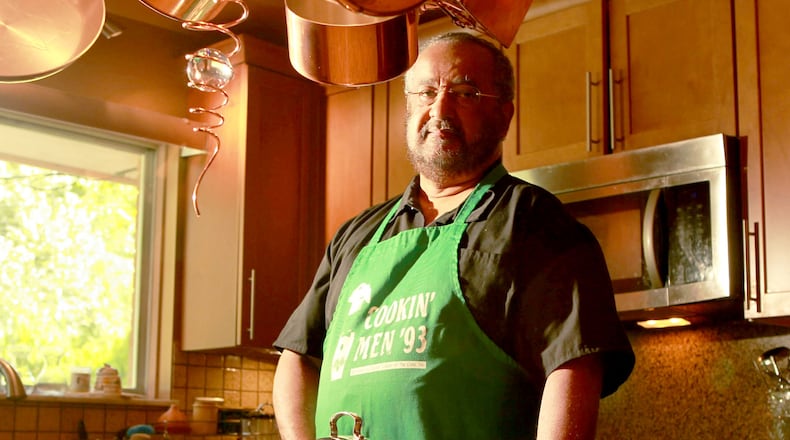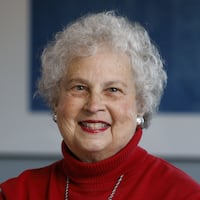JOHN FLEMING’S WHITE NAVY BEAN SOUP
Ingredients
- 1 16-ounce package white beans
- large ham hock
- 1 large onion
- 1 teaspoon ground pepper
Soak the beans overnight in water. Boil the ham hock in water or chicken stock until well done. Dice ham hock and return to pot. Dice the onion and add to the pot, adjust the liquid to two quarts. Bring the beans to a boil, drain and add the hot beans to the stock. Cook until beans turn soupy. Add pepper, salt to taste. Add hot sauce if desired. Serve with corn bread.
SPOTLIGHTING GOOD COOKS THROUGHOUT REGION
In this weekly food feature, Life reporter Meredith Moss chats with cooks throughout southwest Ohio who have a passion for food and are willing to share advice and recipes.
If you know a terrific cook — either amateur or professional — please send your suggestion to Meredith: MMoss@coxohio.com Please include a daytime phone number.
How To Go
- What: Cool Soups for a Hot Cause, a benefit luncheon for the Dayton Peace Museum
- When: 11:30 to 1 p.m., Friday, Sept. 13
- Where: Christ Episcopal Church, 20 West First St., Dayton, from 11:30 am to 1 p.m.
- Featuring: Homemade soups, breads, salads, desserts. Call the Museum at (937) 227-3223 or go to info@daytonpeacemuseum.org
- Donation: $20.
- For reservations: Call the museum at (937) 227-3223 or go to info@daytonpeacemuseum.org
Once each year, a group of folks who enjoy cooking for a cause, offer their culinary talents to the Dayton Peace Museum.
The resulting event, a cold soup luncheon, is held each September. A second fundraiser, featuring hot soups, is held in March and showcases hot soups donated by various area restaurants.
The gatherings, held in the parish hall of Christ Episcopal Church, are traditionally held on a Friday and feature soup, salad, breads, beverages, desserts and music. Vegetarian options are always included.
This fall’s luncheon, slated for Friday, Sept. 13, will offer up a variety of cool soups including Gary Mitchener’s cucumber soup, Chris Saunders’ Russian borscht, Joan Franks’ red gazpacho, Nancy Alway’s green gazpacho and Mary Ann Gazior’s ginger peach soup. Earth Fare will provide a melon soup.
Guest cook for the special event is John Fleming of Yellow Springs, director emeritus of the Cincinnati Museum Center, who will make a ham and bean soup.
We chatted with John about his love of cooking and his contributions to the fundraiser:
What are your earliest memories of food and cooking?
I think all of our fondest memories of food center on holidays, especially Thanksgiving and Christmas. We did not have a lot of money when I was growing up, but we had the best holidays. My mother, who was a dietitian, was an excellent cook. She would spend the entire day cooking the family meal. The smells from the turkey, dressing, rice, gravy, asparagus and homemade rolls filled the house.
I did not cook at home. But my aunt who lived next door, allowed my sister and me to cook anything we wanted and in the process make a terrible mess in her kitchen. We baked cookies, cakes and made ice cream and pepper relish in the summer. I just completed canning 15 jars of pepper relish.
When my sister got burned by grease popping from frying chicken, my mother got angry at my aunt for letting us do whatever we wanted in the kitchen.
How did you learn to cook?
I never really learned how to cook at home. Even when I was living on my own after college, I did not do much cooking. A meal for me might consist of cold cuts, pickles, olives, cottage cheese, sardines, bread, etc.
I learned to cook when I was in Africa ( Malawi) in the Peace Corps. We all got a “Fanny Farmer Cookbook” in our settlement trunk. It became my Bible. I tried anything and everything and not everything turned out OK. I would actually make hamburger buns for the hamburgers. I had a wood stove, it reminded me of the stove my aunt cooked on.
It was in Africa that I really developed as a cook because you had to be much more than a cook. You had to know when to turn the cake in the oven so that it would brown evenly on all sides. You had to know when to move a pot from the hot side of the stove to the cooler side to keep the dish warm.
When I got home and married my wife, Barbara, I virtually stopped cooking, except for barbecuing. Barbara came from a family of five girls and they each had their responsibility. She was the cook and knew how to cook well. There were only two of us, but she still cooked for six. That is when I started gaining weight, trying to eat for six, to please my bride.
What kind of cooking have you done throughout your life?
Since I love to eat good food, I found over the years that I could cook as good or better than what I was served in restaurants. I started off learning how to cook the perfect steak, then cooking ribs with my homemade sauce, learned to fry the best catfish that people actually would ask me to cook for them. I make gumbo better than any I have eaten in New Orleans. Once I made six cheese cakes for the Dayton chapter of The Links during their cooking men’s fundraiser. All the ladies lined up in front of my table for a sample.
Once I have tasted something, I generally can reproduce the dish or improve on it. I had some wild rice soup once. When asked if I wanted the recipe, I said “No, I can recreate the soup and I did! I added Virginia country ham to the soup and that gave it an added dimension.
While working at the Cincinnati Museum Center, I won the ‘Chili Cook-off’ two years in a row and I don’t even like chili or eat it. I make French and Italian country bread, southern rolls and biscuits, as well as corn bread. I am into Chinese, Greek, Ethiopian, Jamaican — just all types of food that interest me. My next area of exploration will be Thai.
What are some of your favorite dishes?
It’s hard to say. I like Peking duck. When we lived in Columbus, I was making Chinese food from an authentic Chinese cookbook. It called for hanging the duck in a tree for a day. My wife made me go out and get it.
I really like fried catfish with my secret coating. I refrigerate the fish which makes it crispy after frying. I like fried chicken, but my wife has taken it off our menu. My favorite is chitterlings. Unfortunately, I am limited to eating them once a year. I am getting into more soups and seafood. I like bouillabaisse and good Italian bread.
Who do you cook for?
Over the years, I cooked for my wife and family. My daughter has her favorite dishes she wants me to cook when I visit her and her family. My grandboys like my baked beans and mac-and-cheese. When we go on family vacations to the beach, I have to be careful not ending up doing all the cooking. When I was director of the museum at Wilberforce, we would cook for the museum’s volunteers. I would make huge pots of gumbo, homemade breads and lots of cakes — cheese cakes and coconut pineapple cake, my favorite. I like to make pies, but don’t eat them. I made a yellow squash pie, which was gone in a day, in spite of people not being able to identify the pie. I thought that was funny. My daughter in D.C. is an excellent cook. We enjoy cooking together, especially different types of food. She just told me that she wished I could make her some of my oyster-and-sausage dressing.
What are some of your favorite ingredients and how do you use them?
If onions and garlic disappeared from the earth, I think I would stop cooking. I grow my own oregano, onions, garlic, peppers, basil, thyme, sage, dill, etc. It is great using fresh ingredients. I often dry herbs when I have too much. Many of my dishes begin with onions, green peppers and celery.
How did you become involved in the Dayton Peace Museum and the soup events?
As the founding director of the Underground Railroad Freedom Center in Cincinnati, I was active in promoting peace and racial reconciliation. When I retired, I was invited to join the board of the Peace Museum, which I did. I believe in the mission of the museum and the work that they are doing, especially in working with children. However, my consulting work has keep me from attending most board meetings. So I said that I would help with their fundraising when I was in town. I really like making soup for the events. People seem to enjoy all of the soups and the overall event.
What is special about making soup? How does it reflect the mission of the museum?
I like the theme: cold soup for a hot cause. Soup and bread are very fundamental to life around the world. Soup is nurturing and provides substance.
About the Author


